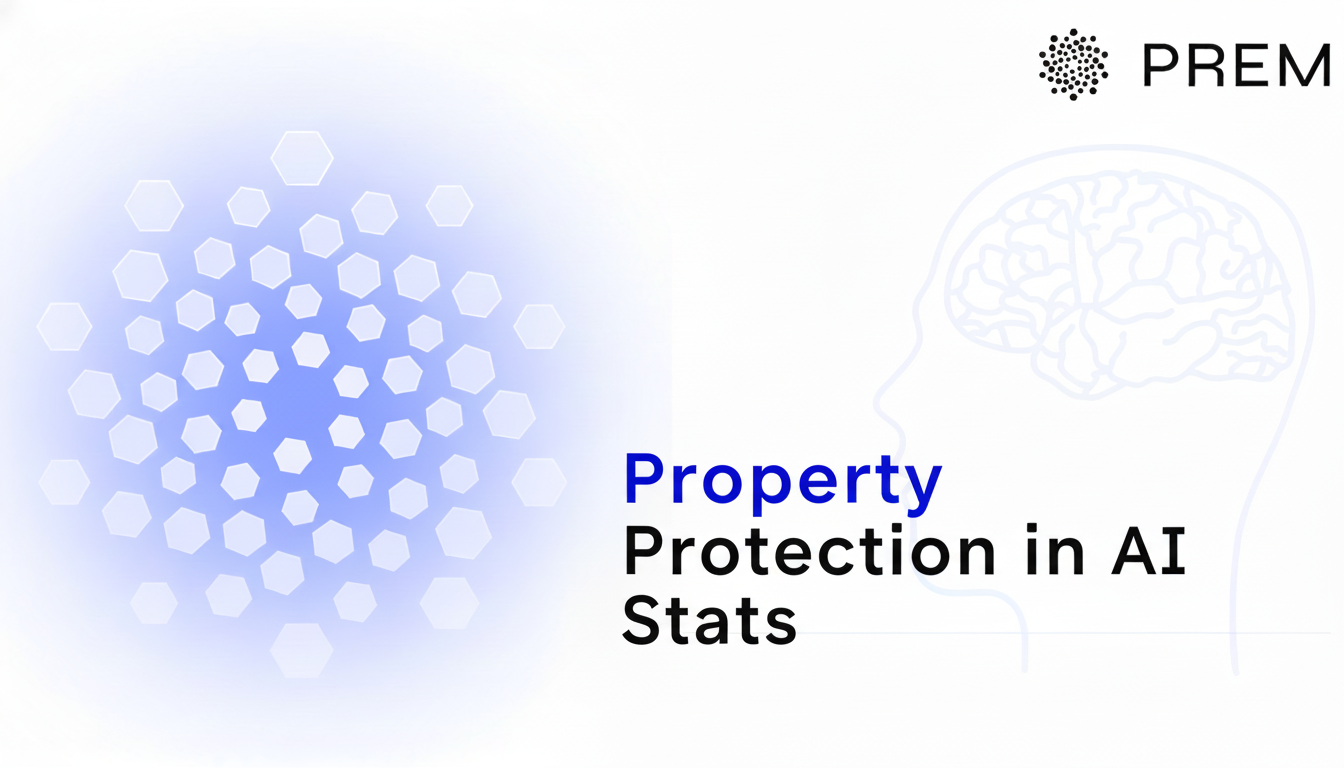7 Intellectual Property Protection in AI Stats
Discover 7 key stats on AI intellectual property protection. Learn why 63% of leaders lack AI IP governance, how data provenance cuts infringement by 68%, and how zero-copy architectures stop data leaks in enterprise AI systems.

Key Takeaways
- 63% of business leaders lack formalized AI roadmaps despite widespread adoption, creating IP governance gaps that expose proprietary models and training data
- Organizations implementing data provenance tracking experience 68% fewer copyright infringement claims related to AI outputs
- 82% of organizations worry about proprietary data leaking into GenAI tools, yet most lack zero-copy architectures to maintain sovereignty
Intellectual property protection for AI systems has become a strategic imperative as organizations race to deploy generative models while confronting unprecedented legal uncertainties around ownership, liability, and compliance. The fundamental challenge stems from AI's unique characteristics—systems that learn from copyrighted materials, generate potentially infringing content, and operate across jurisdictional boundaries with conflicting legal frameworks.
Prem Studio is an autonomous model customization platform with agentic synthetic data generation, LLM-as-a-judge–based evaluations (including bring-your-own evaluations), and Multi-GPU orchestration. It addresses these IP protection challenges at the infrastructure level through zero-copy pipelines that ensure data never leaves the customer perimeter, downloadable model checkpoints for full ownership, and built-in GDPR, HIPAA, and SOC 2 compliance controls that prevent common IP leaks before they happen.
The AI Governance Gap: Strategy Without Security
1. 63% of business leaders currently do not have a formalized AI roadmap
Despite widespread AI adoption across enterprises, most organizations operate without strategic frameworks governing how they will protect intellectual property generated through or embedded in AI systems. This governance vacuum creates multiple exposure points:
- Unclear ownership of AI-generated content leaves assets vulnerable to third-party claims
- Absence of documented human creative input undermines copyright eligibility
- Lack of training data provenance tracking exposes organizations to infringement liability
- Missing audit trails prevent verification of compliance with emerging regulations
The organizations that succeed in protecting AI IP share a common characteristic—they treat governance as foundational infrastructure rather than administrative overhead, implementing controls before deploying production systems rather than retrofitting protection afterward.
2. 74% of business leaders believe AI is essential to protect organizational revenue
While three-quarters of executives recognize AI's strategic importance for competitive positioning, the disconnect between this awareness and formalized protection strategies creates substantial risk. Organizations understand that AI capabilities represent valuable intellectual property yet fail to implement systematic approaches to securing these assets. This gap proves particularly dangerous when:
- Proprietary model architectures leak to competitors through inadequate access controls
- Training data containing trade secrets gets exposed via API-based deployments
- Custom model weights developed at significant expense remain vulnerable to extraction attacks
- Vendor dependencies prevent organizations from maintaining ownership of customized models
Enterprise AI solutions with complete data sovereignty eliminate these vulnerabilities by ensuring all model development, training, and inference occur within customer-controlled infrastructure, maintaining the "Not Your Weights, Not Your Model" principle that defines true AI ownership.
Mergers, Acquisitions, and IP Due Diligence
3. 64% of business leaders plan to use M&A to bolster AI capabilities within 12 months
The AI acquisition surge reflects organizations recognizing they cannot build competitive AI capabilities fast enough through internal development alone. This M&A activity creates intensive IP due diligence requirements as acquirers must verify:
- Clear ownership of model weights and training data without encumbrances
- Documented compliance with copyright and licensing requirements for all training datasets
- Absence of patent infringement in algorithmic approaches and architectures
- Trade secret protections sufficient to maintain competitive advantage post-acquisition
Organizations with well-documented IP positions command premium valuations in M&A contexts, while those with unclear ownership, compliance gaps, or vendor lock-in face substantial valuation discounts or deal failures during due diligence.
4. Over 30% of AI-related M&A transactions completed by financial acquirers
The significant presence of financial buyers in AI M&A demonstrates that AI capabilities have become investable assets with quantifiable value drivers. Financial acquirers conduct particularly rigorous IP due diligence because their investment theses depend on defensible competitive advantages. Key evaluation criteria include:
- Sovereignty over core AI assets enabling independent operation without ongoing vendor dependencies
- Comprehensive IP protection preventing competitive erosion of acquired capabilities
- Regulatory compliance documentation reducing legal exposure and remediation costs
- Clear audit trails demonstrating ethical data sourcing and model development practices
Organizations deploying AI on sovereign infrastructure with complete ownership of model weights and training pipelines present lower risk profiles and higher strategic value in M&A transactions.
Geographic Variations in IP Protection Frameworks
5. The USA leads global IP protection rankings with an 8.01 score
The United States maintains the strongest intellectual property protection framework globally, followed by Austria, Sweden, Germany, and Singapore. This leadership position stems from:
- Comprehensive patent system covering AI algorithms and processes
- Clear copyright framework requiring human authorship
- Strong trade secret protections under the Defend Trade Secrets Act
- Well-developed case law providing guidance on AI-related disputes
However, the U.S. approach creates challenges for purely AI-generated content, as the Copyright Office consistently holds that works lacking human creative input cannot receive copyright protection. Organizations operating in the U.S. must therefore document substantial human involvement in AI-assisted creation processes to maintain IP protection eligibility.
6. Congress introduced the Generative AI Copyright Disclosure Act requiring training dataset transparency
The proposed legislation would mandate that developers of generative AI models disclose datasets used for training, fundamentally changing the AI development landscape. This transparency requirement aims to:
- Give copyright owners visibility into whether their works were used without permission
- Enable rights holders to opt out of future training uses
- Create accountability for data sourcing practices
- Establish baseline documentation standards for AI development
Organizations already maintaining comprehensive data provenance tracking will adapt seamlessly to such requirements, while those with undocumented or questionable data sources face potential regulatory violations and forced model retraining. The Act reflects broader global trends toward greater transparency in AI training practices.
The Data Leakage Crisis in Enterprise AI
7. 82% of organizations worry about proprietary data leaking into GenAI tools
The overwhelming security concern around data exfiltration through AI systems reflects well-founded fears about intellectual property exposure through multiple vectors:
- Prompt injection attacks manipulating systems to reveal confidential training data
- API-based deployments sending proprietary information to third-party providers
- Model extraction techniques reverse-engineering valuable algorithmic approaches
- Employees inadvertently exposing trade secrets through interactions with public AI tools
Despite widespread concern, most organizations lack architectural solutions preventing data leakage at the infrastructure level. Traditional security controls designed for static data prove insufficient for AI workloads where data flows continuously through complex pipelines. Zero-copy architectures address this vulnerability by ensuring data never leaves customer-controlled perimeters, preventing exposure regardless of employee behavior or system vulnerabilities.
Building IP-Secure AI Infrastructure
The intellectual property challenges facing AI deployment stem fundamentally from misalignment between traditional legal frameworks and AI's unique characteristics. Organizations attempting to secure AI IP through compliance exercises applied to conventional architectures encounter persistent vulnerabilities because the infrastructure itself lacks sovereignty.
Effective IP protection requires purpose-built platforms implementing several core principles:
Complete Data Sovereignty Zero-copy pipelines ensure proprietary training data never leaves customer-controlled infrastructure, eliminating exposure to third-party systems. Organizations maintain custody of intellectual property throughout the AI lifecycle from data preparation through model deployment.
Comprehensive Audit Capabilities Detailed tracking of data lineage, model development decisions, and human creative input provides the documentation required for copyright registration, regulatory compliance, and legal defensibility. Real-time monitoring enables continuous verification of IP protection measures.
Flexible Deployment Options On-premise, cloud, and hybrid configurations adapt to varying data residency requirements across jurisdictions while maintaining consistent governance controls. Organizations can segregate processing of sensitive data onto local infrastructure while leveraging cloud resources for less critical workloads.
Model Ownership Architecture Downloadable checkpoints in open formats enable organizations to deploy models via vLLM, Hugging Face, or Ollama without vendor dependencies. True ownership of model weights prevents lock-in and supports trade secret protection strategies.
The convergence of increasing regulatory scrutiny, rising M&A activity, and growing investor sophistication around AI IP makes comprehensive protection frameworks business imperatives rather than optional compliance measures. Organizations establishing robust IP governance now gain competitive advantages that compound over time as legal frameworks mature and enforcement intensifies.
Frequently Asked Questions
What percentage of organizations lack formalized AI IP protection strategies?
63% of business leaders currently operate without formalized AI roadmaps, creating substantial IP governance gaps. This absence of strategic frameworks exposes organizations to multiple risks including unclear ownership of AI-generated content, inadequate training data documentation, and missing audit trails for regulatory compliance. Organizations implementing comprehensive IP frameworks experience 65% reduction in legal exposure and resolve disputes 37% faster than those without systematic protections.
What security concerns dominate enterprise AI deployment decisions?
82% of organizations worry about proprietary data leaking into GenAI tools through prompt injection attacks, API-based deployments exposing information to third parties, and model extraction techniques reverse-engineering valuable algorithms. Despite widespread concern, most lack architectural solutions preventing leakage at infrastructure level. Zero-copy architectures that ensure data never leaves customer perimeter address these vulnerabilities while maintaining complete sovereignty over intellectual property.
How does AI IP governance affect valuation in M&A transactions?
Organizations with comprehensive IP governance frameworks can achieve higher investor confidence because defensible IP positions determine competitive sustainability. With 64% of business leaders planning AI-related M&A within 12 months, due diligence now routinely examines training data documentation, trade secret protections, human authorship evidence, and regulatory compliance frameworks. Organizations with well-documented IP positions command premium valuations while those with unclear ownership face substantial discounts or deal failures.
